Well, that episode sure isn’t going to silence any critics. If anything, it’ll add more fuel to the fire of those who want to know what the eff is going on and why the show’s not answering any of their questions. Patience, all who have ants in their pants; the answers will come in time, but not in this post.
Speaking of time, the last episode made sure viewers have become aware of its importance (MITTELOS=LOST TIME), and tonight’s ep takes it a step further by turning our perception of it on its head. What at first seems to be a traditional flashback to Desmond’s past turns out to be an altogether new look at the past…in present time. I feel like Doc Brown should be stepping in right about now to say something about flux capacitors. Let me get some bullet points out of the way so I can try and make some sense of all this with an all-encompassing, awe-inspiring conclusion.
- Charlie’s sign propped up in his guitar case displays his name as “Charlie Hieronymous Pace.” A bit o’ history on the namesake:
Hieronymus Bosch, (c. 1450 – August, 1516) was a prolific Dutch painter of the 15th and 16th centuries. Many of his works depict sin and human moral failings. Bosch used images of demons, half-human animals and machines to evoke fear and confusion to portray the evil of man. The works contain complex, highly original, imaginative, and dense use of symbolic figures and iconography, some of which was obscure even in his own time. He is said to have been an inspiration for the surrealist movement in the 20th century.
Seems like Des’s painful flashes of his past would be right up Mr. Bosch’s alley.
- Remember the out-of-place Island polar bears?
A polar bear attacking an upside-down Buddha? Google Powers Activate!
Ananda was puzzled by why we have lost sight of our true nature. The Buddha replied that ordinary sentient beings do not see clearly because of their preconceived views. What they think is upside down, may be right side up. What they believe is correct, may be incorrect. The Buddha placed his hand down, and asked Ananda whether his hand was right side up or upside down. Ananda replied that it would be commonly held that the hand was in an inverted position, but he did not know whether the position was correct or inverted. The the Buddha explained that since we were born with our hands hanging down at our sides, perhaps the hand pointed up is really in an inverted position. Ananda knew what the view of a common man might be, but he also knew that this was not the Buddha’s view. The Buddha used this analogy to show that the average person has a mind that creates discriminations, and that what he believes to be true, may in fact be false. [Chan Newsletter]
Perhaps a lesson in not always accepting what we see at face value.
- I couldn’t help but think of Dorothy in The Wizard of Oz when the Jeweler Woman made note of the guy on the street’s red shoes. Click your heels three times and you can go home?
Along with the polar bear painting, you could construe this as further evidence that what you see isn’t always what you get. Desmond might want to take note of this at some point if he’s any hope of changing his path in life.
And that brings me to the concept of fate, which seems to be the central theme tonight. We overhear the Indian scientist talking to a colleague about a “wild card market,” in which there is a high degree of unpredictability. Myriad factors combine to make for all manner of outcomes in each market transaction–in each choice. Life is a wild card market, each choice we’re presented with offering an infinite array of possibilities and outcomes–an infinite number of paths, when a life’s worth of choices is taken into account. If we accept this basic concept to be true, that the sum of the choices we make in life can lead to myriad potential outcomes, then how do we reconcile that with the concept of fate? One can view fate as an anchor that pulls you toward an inevitable outcome–or one can view fate as the simple result of all the choices we make along the ride we call life.
Desmond clearly seems to view it as an anchor, accepting Jeweler Woman’s matter-of-fact urging that his path in life is set; he can’t go back and ultimately change the decisions he’s made in his past. Of course, when he accepts this to be true, he ends up right back on the Island–his fate after the choices he made in leaving Penelope, joining the Royal Scots and embarking on a sailboat race. Despite Jeweler Woman’s statements on life’s “course corrections” resulting in the same fate regardless of our actions and choices, I’m guessing there’s a lesson for Desmond to learn.
Is it a lesson in not dwelling in the past? Or is this all a warning to throw fate to the wind and live in the present while making choices accordingly? Hey, I could be wrong, but I think this question is integral to the focus of the show. These castaways have repeatedly accepted their fates, whether resigning themselves to living the remainder of their lives on the Island or pushing a button every 108 minutes. Their future will undoubtedly hinge on whether they figure out they can make their own choices and change the future instead of sitting around waiting for their fates to arrive. Charlie’s fate may or may not be to meet his demise on the island from a lightning bolt or a hanging or drowning. If course corrections are going to result in his death anyway, Desmond’s wasting his time. But if he–along with the castaways and Others–can come to the realization that fate doesn’t have to be anchor and he can determine what happens, we may be in for some drastic and welcome new plot developments.
I haven’t specifically dealt with who that Jeweler Woman is and how she could be appearing in Des’s flashbacks (which I don’t think are actually flashbacks at all) because I simply don’t right now. I don’t recall having seen her on the show before, so her allegiance, if any, is unknown to me at this time. If I had to guess at this point, I’d say she’s yet another Island apparition courtesy of ole’ Cerberus.
We’ve seen that the security system has the ability to scan and catalogue the castaways thoughts and memories (remember the scans of Eko?). If it can do that, it wouldn’t be much of a reach to assume it could knock Desmond out and make him believe he was reliving his past. Factoring in the fate equation, it would make sense because the Island–for whatever reason–has made it a point to keep our castaways present and accounted for on the island a number of times.
Quick Hits
- A quick recap of last week’s references to Aldo and his A Brief History of Time reading session that was so rudely interrupted. It’s been discovered he was reading pages concerning black holes and their effects on space-time. Seeing as how time has become so large a factor, it stands to reason this may be one of those relevant Easter Eggs that gets lost amid all the other tangential refuse I discover each week. Could we see another Dharma station designed to study and even create these singularities?
- A possible link with the NBC show Heroes? The Indian physicist Desmond spoke with was played by an actor from said NBC show–a character very similar to the one he played on tonight’s Lost.
Show creator Damon Lindelof jokingly said in an interview that Heroes and Lost take place in the same universe. Perhaps a bit of stunt casting to tease the fans.
- Those lovable Numbers make a few appearances:
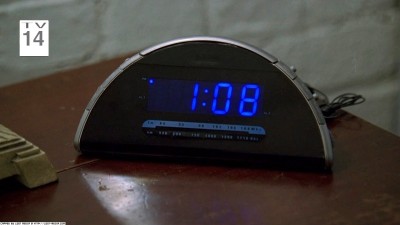
The clock in the apartment (sum of #’s=108)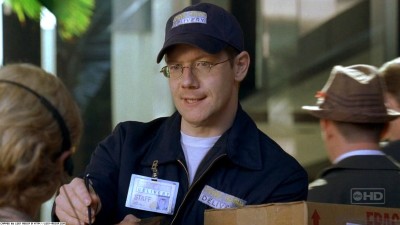
The courier has a parcel for 815 (Oceanic Flight 815, 4 8 15 16 23 42) - Hurley is seen reading Vladimir Nabokov’s Laughter in the Dark, a 1932 novel that “deals with the affection of a middle-aged man for a very young woman, resulting in a mutually parasitic relationship. In 1955, Nabokov used this theme again with Lolita to a much greater effect.” [Wikipedia]
- The jukebox in the pub was a VENUS. Buy one now! After references in Lost’s past to other figures in Roman mythology (Persephone and Penelope, to name two), I thought for sure there should be some deeper meaning. But maybe it’s just a jukebox.
- Lots of music use in this episode. Sarah McLachlan’s Building a Mystery (how appropriate), Oasis’ Wonderwall (which is making for a good soundtrack to this post right now), and our old favorite Make Your Own Kind of Music by Mama Cass (from the season two premiere).
Other Stuff From Other Sites
- More from Hieronymus:
As explained mostly by Astounding Science Fiction editor John W. Campbell in late 1950s and early 1960s editorials, Hieronymus machines were mockups of real machines (patented by their inventor, Dr. Thomas Galen Hieronymus) which allegedly worked by analogy or symbolism, being directed by psi or ESP powers.
As an example, one could create a receiver or similar device, with prisms and vacuum tubes represented by their cardboard or even schematic representations. Through the use of mental powers, such a machine would function as would its “real” equivalent. Campbell claimed that such machines actually did perform this way, but the concept was never taken seriously elsewhere or followed through on in later years. [Wikipedia]
Has Desmond created such a “machine” for himself?
- “Namaste,” the Dharma phrase for “good-bye” or “good health” is seen written backwards on the aforementioned polar bear painting. [Sledgeweb]
- The paint can spilled all over Desmond’s apartment had “FUTU-” written on it. “FUTURE?” AH-HA! THE SECRET OF THE ISLAND HAS TO DO WITH RED PAINT!!!! [Sledgeweb]
- Oceanic is getting all kinds of free advertising lately. [Sledgeweb]
See you next week–it’s your destiny.
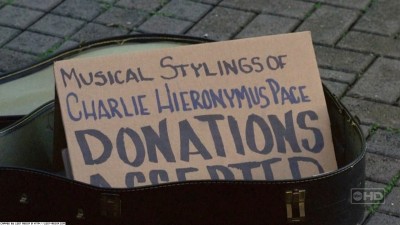
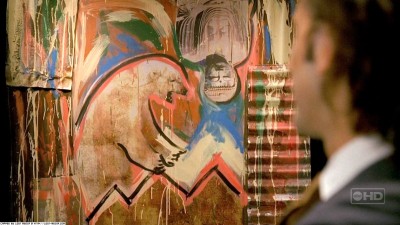
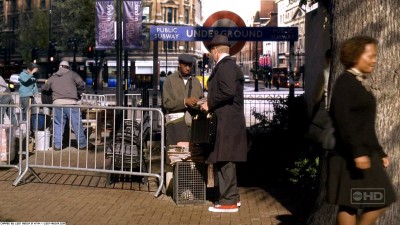
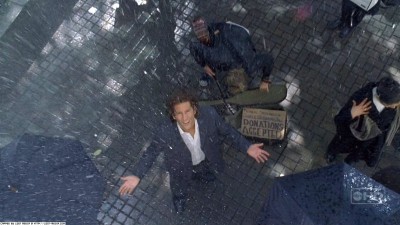
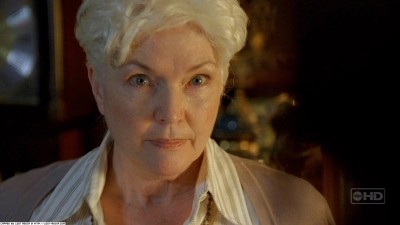
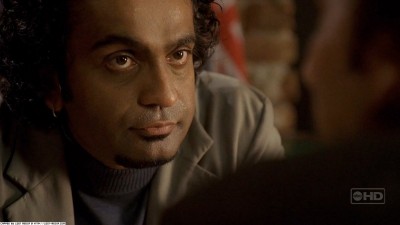

Not my pickup, but someone noticed a telling lyirc from Wonderwall considering who’s singing it in whose vicinity:
“Maybe
You’re gonna be the one who saves me.”
Slick shoes, Lost.